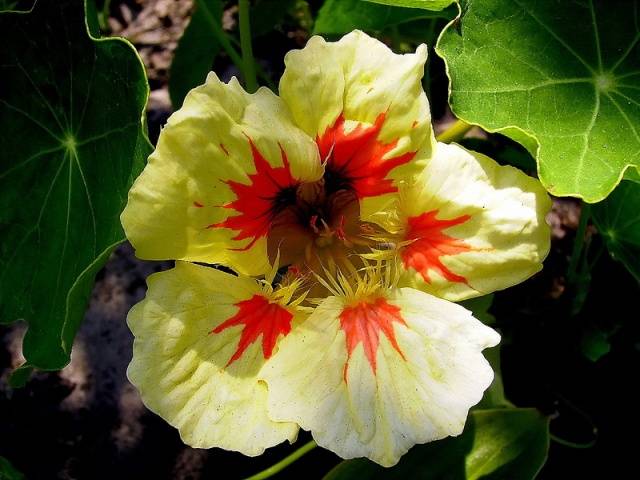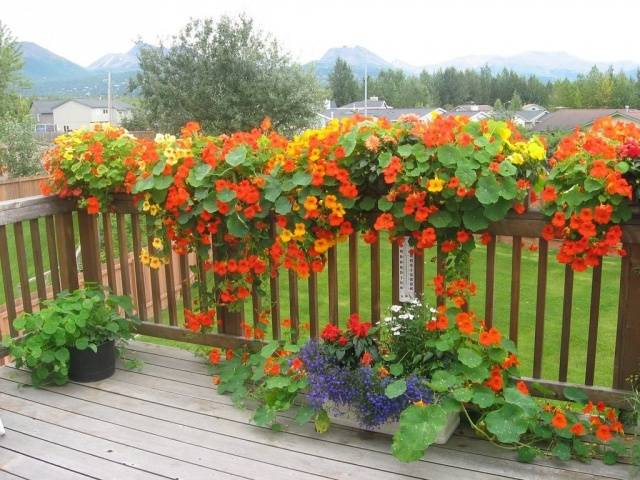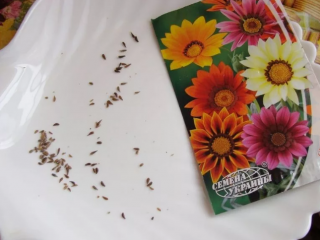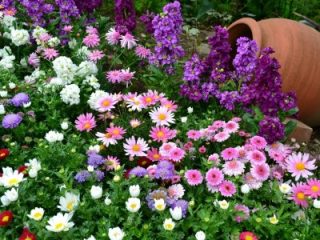Content
Balconies and loggias, gazebos and attics, borders and paths - nasturtium will help decorate any corner of the garden, highlight its advantages and hide some imperfections in the walls or a rickety fence. It is advisable to grow this picky flower in poor soil.
Abundant and long-lasting flowering is another advantage of the plant. Planting nasturtium in open ground and subsequent care is not burdensome. But there are some nuances that you need to know about in advance.
Familiar Stranger Capuchin
Nasturtium has another name - Capuchin. Some sources mention that “Capucin” is the real name of the plant, but it was called nasturtium much later.
Nasturtium belongs to the genus of herbaceous plants of the family. Nasturtsievs. This genus includes about a hundred plant species native to Central and South America.
The Nasturtium family includes perennial and annual flowers with a succulent, weak and branched stem and unusually bright and beautiful inflorescences, shaped like the pointed hood of the monks of the Franciscan order. It is for this similarity that he received his name “capuchin”.
The variety of nasturtium species is very large. Among them you can find creeping, bushy plants, and there are also “climbing”, so-called vines (not to be confused with climbing ones), which cling to any support or other plants.
The height of the plant varies on average from 20 cm to 200 cm, depending on the type and variety of flowers. Creeping nasturtiums have a height of 20 to 50 cm, but climbing varieties of plants grow up to 1.5-2 m. More recently, new varieties have appeared on the market, reaching 3.5-4 m in height and they belong to long-climbing plants.
Nasturtium leaves are shield-shaped or lobed, alternate in arrangement, attached to the stem with a long petiole.
Capuchin flowers are solitary, mostly bisexual, emit a very delicate and pleasant aroma, consist mainly of five uneven petals (a larger number of petals can only be found in varietal plants), the same number of sepals, an ovary and a funnel-shaped tube.
Previously, the color scheme of nasturtium flowers was represented by only three colors - red, yellow and bright orange. But the variety of shades amazes with their brightness and uniqueness.Thanks to breeders, many new varieties of this plant have recently appeared, and among the usual colors you can find snow-white, crimson, even brown inflorescences.
Despite the fact that in their homeland nasturtiums are perennials, in our country, in harsh climatic conditions, they are grown exclusively as annual flowers.
Nasturtium has long been known for its medicinal properties, and some parts of the plant are often used in cooking as a component of main courses and salads.
Annual flowers are most often propagated by sowing nasturtium seeds in open ground. They sprout quite quickly, grow excellently and bloom profusely and luxuriously throughout the summer.
Growing rules
Growing nasturtiums (pictured below) is not such a difficult process. Even a novice florist can cope with a number of familiar and familiar recommendations, and you will not be required to have any specific skills or abilities. However, it is worth familiarizing yourself with some of the features that are the key to lush, delightful nasturtium flowering.
When to plant
The timing of planting nasturtium seeds depends on the method of growing flowers (seedlings or non-seedlings), as well as the climatic characteristics of the region.
If you decide to sow nasturtium seedlings, you can start working approximately in early to mid-April. Transplanting flowers into open ground begins no earlier than 1-1.5 months after sowing.
Grown seedlings are transplanted into the flower garden only after the threat of spring night frosts has passed. In the central regions, flower replanting begins in mid-to-late May.But in regions with a more severe climate, you should not start planting work before the end of May - beginning of June.
Flower growers begin sowing nasturtium seeds directly into open ground no earlier than mid-to-late May. This late planting date is due to the return frosts characteristic of the beginning of the month. And in some regions this deadline may move 1.5-2 weeks later. With sharp drops in temperature, young flower shoots will inevitably die.
Which site to choose
The Capuchin loves light and warmth and is intolerant of drafts. Therefore, the place for growing nasturtium in open ground should be selected according to its preferences.
A well-lit area, protected from piercing winds, is an ideal place for a future flower bed. Weak and juicy nasturtium stems instantly break under strong gusts.
In shaded areas where the amount of sunlight is limited, nasturtium will grow weak. The bushes will have a large number of stems and an abundance of green foliage. It is unlikely that you will see flowers on the plants during the summer season.
Areas with a high level of groundwater and also places where water stagnates in the spring and after rain are completely unsuitable for growing nasturtium in open ground. Excessive moisture is the first enemy of flowers and the root cause of putrefactive diseases.
It would be a shame if, after putting in so much effort, these beautiful flowers die from such a trifle as the wrong location.
What soils are preferable
Before planting nasturtium, it is important to decide what soil the flower prefers. Sometimes, even when following agricultural cultivation techniques, some gardeners note that the plant gains green mass well, but no flowering is observed. Or rare flowers with a pale color appear on nasturtium bushes.
The reason for such failures may be either an incorrect feeding system or too fertile soil. The flower will devote all its energy to the formation and active growth of young shoots.
Therefore, it is advisable to plant nasturtiums in the lungs, with moderate indicators for the composition of soil minerals.
Too poor soils are also not the best place for growing nasturtium. In such conditions, the plant will stretch upward. The appearance of a flower grown in poor soil will be unattractive - long, weakened shoots with a small number of small leaves and no flowers.
Growing nasturtium in heavy, clayey soil will also not be successful. In this case, the flower is often affected by various diseases, which leads to the death of the plant.
Lightweight, with low soil acidity, with a good drainage layer - this is an ideal option for planting nasturtiums in open ground and subsequent care.
Which growing method to choose
There are two ways to plant nasturtium seeds in the ground - seedlings, which are familiar to all gardeners, and without seedlings. Each has its own tricks and limitations, which dictate the structural features of the plant’s root system and the recommended rules of agricultural technology.
Features of growing seedlings
Before growing nasturtium seedlings from seeds, it is important to know that the plant’s root system is very fragile and takes a long time to recover from the slightest damage. It is advisable to take care in advance to ensure that later, when transplanting flower seedlings into open ground, the roots are damaged as little as possible.
Please note that when growing nasturtium for seedlings, you will have to eliminate the picking process. Therefore, sowing seeds should be done in separate cups with a retractable bottom or peat cups.
One seed is planted in each container with a drainage layer laid on the bottom and filled with soil, covered with a two-centimeter layer of soil and provided with proper care.
The recommended room temperature when growing nasturtium seedlings ranges from +20˚С +22˚С. You will see the first green flower shoots in approximately 1.5-2 weeks. Make sure that the seedlings receive enough light, otherwise the seedlings will stretch out and be very weak.
When planting nasturtium seedlings in open ground, observe the recommended interval between seedlings, which depends on the variety and type of plant. Thus, for creeping varieties of flowers, the optimal planting distance varies between 20-30 cm, for vine varieties - up to 40-50 cm. The instructions for each variety of nasturtium, indicated on the package, will help you more accurately determine the acceptable distance.
Nasturtium seedlings need to be replanted in moist soil, along with a lump of earth, to avoid damage to the delicate root system.When growing flower seedlings in peat cups, the seedlings will be placed in the planting holes along with the cups.
When planting nasturtium in the ground, pay attention to the weather forecast - even slight frosts will reduce your efforts to zero. Flowers die immediately when the temperature drops sharply. Start work no earlier than the daytime temperature outside has reached +18˚С +20˚С.
Flowers bloom 1-1.5 months after transplanting into open ground. The flowering process continues until the first night frost. So you can enjoy the luxurious, vibrant colors of nasturtiums until fall.
Seedless method
The seedless method of growing nasturtium flowers in open ground is less troublesome and requires much less effort and time. In addition, plants gain color 2-3 weeks earlier than those grown by seedlings.
Moreover, when planting nasturtium seeds directly into the ground, gardeners noted that they grow stronger and are less susceptible to various diseases.
Planting a capuchin
To speed up germination and in order to provoke the earlier appearance of the first inflorescences, flower growers resort to one trick. Before planting nasturtium seeds in open ground, the seed material is soaked for 2-3 days in warm water. The hard surface shell will soften, the seeds will swell, and then they can be planted in the ground.
In a flowerbed prepared in advance, make small holes with a pitch of 25-30 cm and a depth of 2-3 cm. In each planting hole, evenly place 3-4 nasturtium flower seeds and sprinkle with soil no more than 2-3 cm thick. Water the plantings with warm water .
Immediately after planting nasturtium, it is recommended to cover the beds with lutrasil or agrofibre to retain heat and speed up seed germination. In addition, this measure will protect your plantings from possible frosts.
If there is a threat of a drop in temperature, you can additionally cover the sown flowers with plastic film or rags. After just 12-15 days you will see the first shoots.
Subsequently, the beds need to be covered only at night for 2-3 weeks. After this, the cover can be removed.
Aftercare for flowers
Like all flowers, caring for nasturtium after planting (photo below) comes down to following standard procedures. And although this plant requires minimal attention, do not forget about watering, weeding, pruning faded inflorescences and fertilizing. And then the capuchins will definitely thank you with magnificent, bright flowers.
To guarantee long-term flowering after planting nasturtium in open ground, care comes down to regular and moderate watering. At first, you only need to water the beds with warm, settled water. During the period of active growth, flowers will require abundant watering.
With a lack of moisture, the flowers become very weak. If there is too much moisture, the roots of the flowers will rot and the plant may die. Moreover, on moist soils, very sparse flowering of nasturtium is observed with active growth of bushes.
When the first buds appear, the volume of watering should be reduced. Water nasturtiums only as needed. Keep the soil in the flowerbed moist, and this will be enough for the plants.
An important stage in caring for nasturtiums after planting in open ground is weeding. Make sure that weeds do not choke the flowers, otherwise they will stretch upward. Outwardly, such plants look bare and unattractive.
As soon as the flowers grow to a height of 15-18 cm, you can mulch the soil. This simple procedure will greatly simplify your work. The mulch layer will retain moisture. There are much fewer weeds in mulched beds.
For longer and more luxuriant flowering, flower growers promptly remove wilted flowers from the bush. This event will help the plant direct all its strength and nutrients to the formation of new inflorescences.
However, if you want to prepare the seeds of your favorite flowers yourself, you can leave several ovaries on the selected plants.
In general, flowers do not need additional nutrition. But if you wish, you can feed nasturtium with potassium-phosphorus fertilizers. Fertilizing can be done once every two weeks until the first buds appear. Subsequently fertilizing the flowers is not recommended.
By autumn, the splendor of nasturtium flowering gradually decreases. From this point on, you need to reduce watering. When the vegetative process reaches its final stage, the annual bushes are removed from the site and the soil is dug up.
Diseases and pests
Pests very rarely choose nasturtium as a home and food. Moreover, it repels many pests from neighboring plants. So plant these flowers between your vegetable beds and you will notice that:
- whiteflies;
- aphid;
- Colorado beetle;
- cabbage butterfly
will be rare guests in your garden.
But flowers are less resistant to diseases. When growing nasturtium you may encounter the following problems:
- The lower leaves wither and turn yellow, subsequently the entire plant becomes sick and dies. The cause is bacterial wilt.
- Small dots on the leaves surrounded by a red-brown border indicate that the plant has ring spot disease.
- Dry, gray-brown spots on leaves and shoots. The reason is gray rot.
- The appearance of mosaic patterns on the leaves. This is how mosaic manifests itself.
- The appearance of black and brown spots on the foliage, turning into tubercles. The reason is rust.
In all cases, affected plants should be removed from the site and, if possible, burned. Healthy flowers need to be urgently treated with special preparations to prevent the spread of diseases.
How do capuchins reproduce?
Both perennial and annual nasturtium reproduce mainly by seeds. But flower growers are essentially testers and experimenters. And, wanting to preserve and increase the most exquisite and rare specimens of flowers, they resort to cuttings.
Collection and preparation of seeds
You can collect and prepare your own seeds from almost all varieties of flowers. Except, of course, hybrid ones. They are not able to preserve the varietal qualities of the plant. And what will grow from such seeds is unknown.
When growing nasturtium, it is important to timely note the strongest plants on which beautiful and excellent flowers bloomed. This can be done using colored ribbons or strings.
Not all types and varieties of nasturtium have time to ripen before autumn. Therefore, you need to monitor the seed pods. Once they change color and turn whitish, they easily separate and fall off. Don't miss this moment and try to collect nasturtium flower seeds a little earlier.
Nasturtium seeds ripen well at home. Dry the seed material, let it ripen, and store it.
Is it possible to propagate from cuttings?
Recently, a lot of information has appeared about the vegetative method of propagation of nasturtium. But this method, unlike the seed method, does not guarantee healthy and strong plants.
You can try to propagate very rare or hybrid varieties of flowers using cuttings. In this case, if the outcome is successful, the young plants will retain all the characteristics of the original variety.
Carefully separated flower cuttings are rooted in water with the addition of a stimulant for the formation and growth of roots, and subsequently transplanted into large flower pots. Until spring, rooted nasturtium is grown on the windowsill, and with the arrival of spring it is planted in open ground.
The author of the video will tell you and show you how to properly plant nasturtium in open ground.
Conclusion
Bright, inimitable lanterns of nasturtium flowers, sparkling in bright green foliage, can decorate any corner of your garden, balcony or loggia, attic or gazebo.
Planting nasturtium in open ground and subsequent care is not particularly difficult and does not require any skills. Even a beginner can cope with this simple task. And a grateful plant will give you a wonderful mood and the pleasure of contemplating magnificent and unique flowers.

































